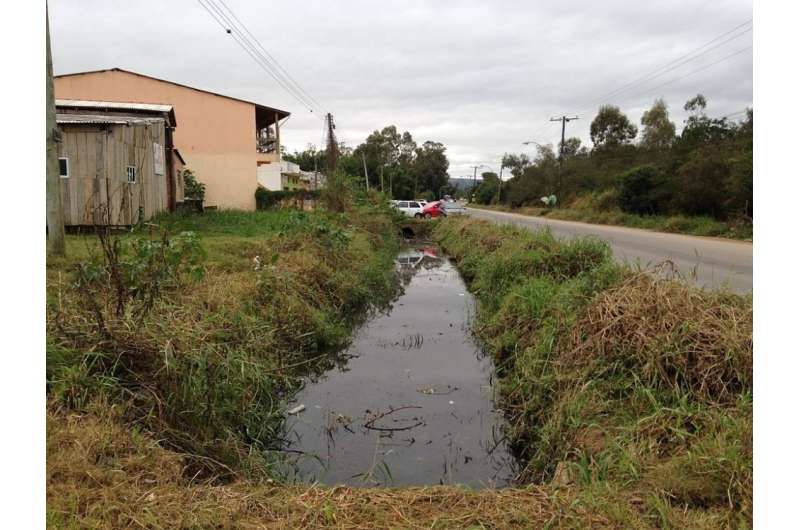Algae used to depollute sewage and produce compost

Sewer treatment systems are designed to avoid discarding large amounts of carbon, phosphorus and nitrogen, components of the organic matter load mainly comprising feces and urine, into watercourses. The massive dumping of such substances in watercourses causes eutrophication, the excessive growth of aquatic microorganisms, especially algae. This leads to potentially serious imbalances in aquatic communities and releases pathogens into the environment.
However, common phosphorus/nitrogen removal techniques have an undesirable effect. The reaction between these substances and the chemical additives employed in the process produces residuals in the form of a low-applicability, onerous sludge, explains Luiz Antonio Daniel, a professor at the University of São Paulo's São Carlos Engineering School. "Some Brazilian states ban its use as fertilizer in agriculture, for example," he explained. "The sludge ends up being discharged into landfills. The cost of disposal is therefore considerable."
One way of making sewage treatment as sustainable as possible is to implement a decentralized system. Therefore, the so-called "black water" of household waste, the effluent's "heaviest" fraction consisting mainly of a relatively undiluted mixture of feces and urine, would be sent to mini-centers serving smaller populations from house units to small-size towns, rather than to big waste treatment plants. The black water would be processed by single-cell algae, which help to remove the pollutants and simultaneously produce large amounts of biomass for such uses as composting. This model is being studied by a partnership between Dutch and Brazilian scientists.
In the reactors tested by the EESC-USP team, microalgae of the species Chlorella sorokiniana, use nitrogen and phosphorus from black water and the micronutrients present in human waste to multiply. Specifically, because they absorb the nitrogen and phosphorus in black water, the algae are rich in these elements, which are essential to the industrial-scale fertilizers applied today.
"It wouldn't be necessary to decentralize excessively. We needn't treat the sewage of each home or building separately. We could have units serving a few thousand inhabitants, up to some 10,000," Daniel estimated. "Because approximately 50 percent of Brazilian towns have fewer than 10,000 inhabitants and only 25 percent have sewage treatment systems, many localities can introduce such systems from scratch."
Grietje Zeeman is an Emeritus Professor in Wageningen University's Department of Environmental Technology in the Netherlands. She recalls that in the 19th century, fecal matter and urine collected from households were used as fertilizer by Dutch farmers. In fact, the system was only deactivated in the early 1980s. "With the system we have today, which can be called 'flush and forget,' this nutrient reuse cycle has been lost. Our idea is to close the cycle again," Zeeman said.
The first step entails decentralizing sewage collection to prevent the dilution of black water and the nutrients in feces and urine. After the algae complete the absorption of organic matter, the next step is collecting the layers of microbes that grow in the liquid. This can be done in two ways, according to Daniel. "In the Netherlands, they mostly use sedimentation, in which a polymer is used to settle the algae at the bottom of the reactor, and they can be collected from there," he said. "Here, we use flotation. We inject compressed air into the liquid, and bubbles form on the surface containing the algae as they float up. A mechanical scraper then collects this biomass and discharges it into a channel."
To leverage this technique, it is necessary to use efficient biomass drying methods, according to Daniel. If algae are stored without being dried, their cells can rupture, and the nutrients to be used at the end of the process can leak out.
The partnership with the Dutch team, he added, has been very useful for purposes of comparison. Considering the differences between the two countries in terms of climate, it is possible to develop methods to optimize the production of algae depending on the context. "The sun doesn't shine year round in the Netherlands as it does here, for example, nor do they have our high temperatures, which sometimes inhibit algal growth. Therefore, the Dutch reactor we've tested at USP gets too hot. To achieve a larger scale, we'll have to make several adjustments," Daniel said.
Optimizing the process so that it works on an industrial scale is the next step in the studies. Field tests will be conducted at the Monjolinho sewage treatment plant in São Carlos.
An advantage of using Chlorella in the process is that these algae are already present in nature and do not require genetic modification to do their work. Hence, there should be no problems with regard to the disposal of treated sewage into rivers and lakes. "If you leave a sample of sewage out in the open, it will naturally be colonized and go green," Daniel said, stressing the importance of seeing black water and other effluents as potential resources.
Provided by FAPESP


















